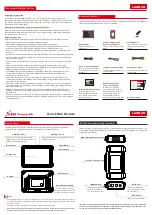
6 of 20
Installation
Before installing the gage, consider the following:
To avoid imposing piping strains on the gage chamber, connect and mount the gage so
that it does not support the piping.
Differential thermal expansion between the vessel and gage can impose severe
mechanical loads on the gage, especially if the vessel contains hot or cryogenic liquid.
To prevent these unwanted loads, install an expansion loop between the gage and
vessel or use a reasonably long run of piping.
Support brackets should be considered for gages over four feet in length or over 150
pounds (68kg) in weight, especially when the gage is exposed to vibration. Support
brackets will prevent overloading the connecting valves and piping and prevent
damage to the gage from excessive vibration.
Always provide shutoff valves between the gage and vessel. Jerguson automatic
safety ball check valves are recommended to help provide protection against physical
injury and loss of product in the event of gasket or glass failure as well as providing a
means to isolate the gage for maintenance.
Correct bolt torque is vital in ensuring the proper operation of the gage. Because
gaskets relax over a period of time, bolt torque should be checked before the gage is
installed and again after the first few hours of operation. See Bringing Gage Into
Service for more details.
o
For gages in high temperature service, see Hot Torque of Glass Gage.
Warning:
Gages should always be isolated from the process fluid system
(by closing the upper and lower shutoff valves) and then vented and drained
to relieve pressure before doing any torque or maintenance checks.






































